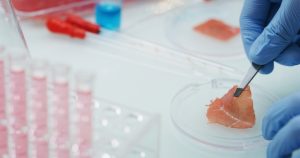In recent years, the concept of lab-grown meat has garnered significant attention. While it’s been touted as an environmental and ethical solution, to some, the concept remains a bit — well — off-putting.
The first cultivated meatball was heralded in 2016 and touted as a “cure-all” to feeding a population of meat-eaters. Over the past seven years, cost, sterility, and, now, the carbon footprint of these products have proven to be barriers to their production.
In a new study, University of California Davis scientists performed a life-cycle assessment to evaluate the energy consumption and greenhouse gas emissions associated with all stages of lab-grown meat production compared to traditional beef production.

Spoiler alert: Lab-grown meat’s carbon footprint may be worse than retail beef
One key challenge the researchers identified was the use of highly refined growth media. Akin to those used in pharmaceutical manufacturing, the process facilitates the multiplication of animal cells.
So, the question then becomes: Is lab-grown meat a pharmaceutical product or a food product?
The author of the study, the doctoral graduate Derrick Risner, explained that the purification of growth media to pharmaceutical levels leads to increased resource usage and subsequently higher global warming potential.
If lab-grown meat continues to rely on this “pharma” approach, it could prove to be more environmentally detrimental and costlier than conventional beef production.
Risner also explained that the purification of growth media to pharmaceutical levels leads to increased resource usage and, subsequently, higher global warming.
The study’s assessment of lab-grown meat’s global warming potential, measured in carbon dioxide equivalents emitted per kilogram of meat produced, reveals that when using purified media, it can be four to 25 times greater than the average for retail beef.

The future of lab-grown meat
The researchers also acknowledge the potential for more environmentally competitive lab-grown meat in the future.
This would involve shifting toward food-grade ingredients or cultures, eliminating the need for expensive, energy-intensive pharmaceutical-grade components and processes. In this scenario, cultured meat’s global warming potential could range from 80 percent lower to 26 percent higher than conventional beef production.
The researchers emphasize that the leap from a “pharma to food” approach represents a significant technical challenge in scaling up the system. They caution against viewing lab-grown meat as a panacea for environmental issues, noting that even the most efficient beef production systems outperform cultured meat across all scenarios.
The study suggests that investments in advancing more climate-friendly beef production may yield faster and more significant emissions reductions than investments in lab-grown meat.
The UC Davis Cultivated Meat Consortium, a collaborative group of scientists, engineers, entrepreneurs, and educators, is focused on developing the technology necessary to transition from a pharmaceutical to a food approach in lab-grown meat production. The consortium aims to explore cell lines suitable for meat cultivation and seek ways to enhance the structure of cultured meat.
»Related: Mammoth meatballs are on the plate in Australia, but not Italy


